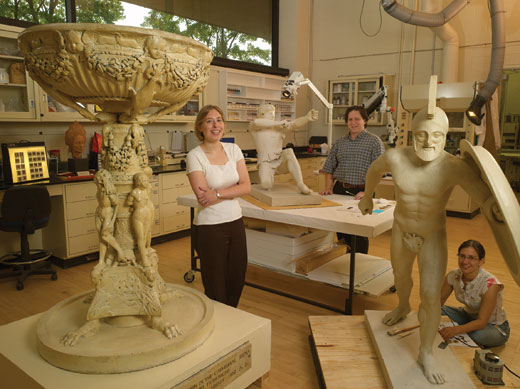
Mattie Schloetzer with Objects Conservator Michael Belman and Conservation Technician Lauren Horelick as they restore casts in Carnegie Museum of Art's conservation laboratory. The casts were taken out of storage and are in the process of being restored for display in the Heinz Architectural Center as part of On a Grand Scale. PHOTO: RIC EVANS
Tracing the Making of a Collection
By Mattie Schloetzer - Curator, On a Grand Scale: The Hall of Architecture at 100
I walk through the Hall of Architecture almost daily. Partly by choice (each time I visit the space, I see something new), and also by necessity (I walk through it on my way to Carnegie Library). Each time, I see a variety of people. Some walk through the space swiftly, while others linger over the labels and take pictures of this unique assembly of plaster casts of architectural fragments and sculpture.
As organizer of On a Grand Scale: The Hall of Architecture at 100, I was excited to learn more about the history of the cast collection. After all, I am a Pittsburgher and a veteran of Carnegie Museum of Art’s famed Saturday Art Classes. I vividly recall our class’ meeting place in the Hall of Architecture next to the cast of Nicola Pisano’s pulpit for the Cathedral at Siena, Italy. However, the task of presenting the results of two years of research was daunting. Would revealing the specifics of how the casts were selected, ordered, produced, and displayed in Pittsburgh be boring to visitors? Worse, would all the information detract from the grandness of the Hall? Two discoveries helped ease these concerns: first, the archival material documenting the planning of the Hall of Architecture and, second, a tour of the Giust Gallery, a cast manufacturer in Woburn, Mass.
My research began in the Heinz Architectural Center’s library, reading the extensive correspondence documenting the formation of the cast collection. The majority of the typed letters, telegrams, and other records are surprisingly legible and show that time was an important factor to John W. Beatty, director of Fine Arts, and his staff. It was crucial that the casts arrive in Pittsburgh in time for the 1907 re-dedication of Carnegie Institute. The guest list for the three-day celebration, which included President Theodore Roosevelt, was impressive.
To meet the imposed deadline, the Institute sought the advice of museum professionals already well-versed in the creation of cast collections and employed agents in Europe to oversee the purchasing and production of the casts. Although there were a number of key people involved in the process, Beatty’s persistence in confirming the production of the architectural casts was remarkable. When it seemed unlikely that a cast of St. Gilles in Gard, France, could be fabricated from the original church, Beatty wrote to the Art Institute of Chicago and the Trocadero Museum in Paris to have molds made from their casts. Many letters and telegrams later, this paper trail had a happy ending. Beatty received the necessary permissions to create a cast of the entire facade from the original, making it the most complete example in existence. For those interested in learning more, the history of this cast will be featured prominently in On a Grand Scale.
Reading through the letters provided me with a better sense of the scope of this endeavor. Perhaps most significantly, the Hall of Architecture defies the notion that forming a cast collection was inexpensive and straightforward. I gained knowledge about where the casts were manufactured (primarily in Europe), how they were transported (crates were shipped to New York City, then sent by train to Pittsburgh), stored (prior to the completion of the 1907 addition, crates were stored in a barn in Shadyside), exhibited in the Hall (pieces of casts had to be re-assembled onsite), and the cost of each replica (from $1 for a fragment to thousands of dollars for the cast of St. Gilles).
The boxes of correspondence were mum on one important topic: the method of producing plaster casts in the 19th century. Fortunately, during my travels researching this project, I met Robert Shure, a professional sculptor and champion of casts. Visiting Shure’s Giust Gallery was an invaluable opportunity to learn more about the production of casts. In addition to viewing examples of 19th-century plaster molds and casts, I was treated to a cast-making demonstration. This reinforced in my mind the importance of showing visitors to On a Grand Scale the process, rather than simply describing it. As a result, members of the staff at the Giust Gallery documented the cast-making process in their studio with a digital camera, and a slide-show of these images will be presented in the exhibition, along with examples of antique and contemporary molds and casts.
Whether you pass through the Hall of Architecture on a frequent basis, or have not visited it in years, my hope is that On a Grand Scale will inform you, inspire you, and encourage a renewed appreciation for the Western Hemisphere’s largest surviving cast collection.
|
 Fall 2007
Fall 2007

